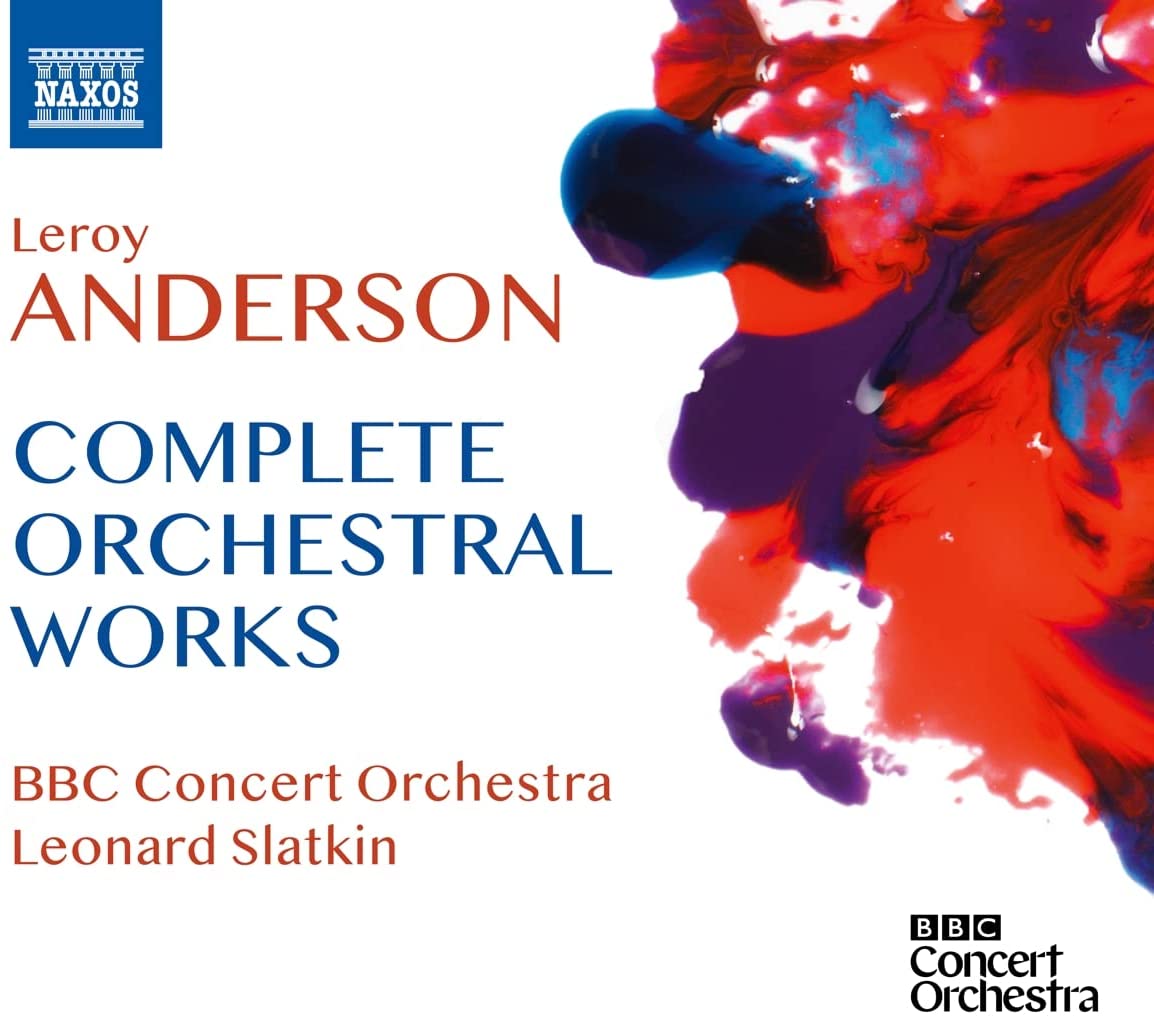 Leroy Anderson: Complete Orchestral Works BBC Concert Orchestra/Leonard Slatkin (Naxos)
Leroy Anderson: Complete Orchestral Works BBC Concert Orchestra/Leonard Slatkin (Naxos)
There’s a lot more to Leroy Anderson than the ubiquitous Sleigh Ride. Though his teachers at Harvard included Enescu and Walter Piston, the polyglot Anderson had intended to pursue a career in languages until the Boston Pops Orchestra’s conductor Arthur Fiedler heard his “Harvard Sketches” in 1936 and commissioned him to write some short pieces. Harvard Sketches is one of many surprises contained in this five-disc set, a brief section depicting a library reading room full of Ivesian effects, the five-minute work ending with a confetti fight. Anderson was a consummate professional, a composer who knew what he was good at and who saw no point in breaking what didn’t need fixing. Try the tiny “Melody on Two Notes”, two serene minutes based on the interval of a perfect fifth. Immaculately orchestrated, it’s sublime. Three of the CDs contain the bulk of Anderson’s short pieces. The favourites are all here, snappily performed by Leonard Slatkin and the versatile BBC Concert Orchestra. Sample Catherine Moore’s idiomatic solo in the “Trumpeter’s Lullaby, or the snappiness of the pizzicato strings in “Plink, Plank, Plunk”. “The Classical Jukebox”, its catchy tune dispatched in a variety of classical styles, includes mechanical jukebox noises and a few seconds of the 78rpm record sticking. In around three minutes. There’s an impressively nimble typist in Anderson’s signature tune, and some entertaining sound effects in an arrangement of “Old MacDonald”.
Rarities include generous selections from Anderson’s charming 1958 Broadway musical Goldilocks, with Kim Criswell and William Dazely on vocal duties. I’m less convinced by the Piano Concerto in C, withdrawn by its self-critical composer and only published posthumously. Premiere recordings include a number of previously unpublished works; Anderson’s output slowed in his final decade (he died in 1975), but the tunes kept on coming. Slatkin’s polished Anderson anthology taped for RCA with the St Louis Symphony can still be found, but this Naxos set is the one to have, the discs recorded between 2006 and 2007. Life-affirming fun.
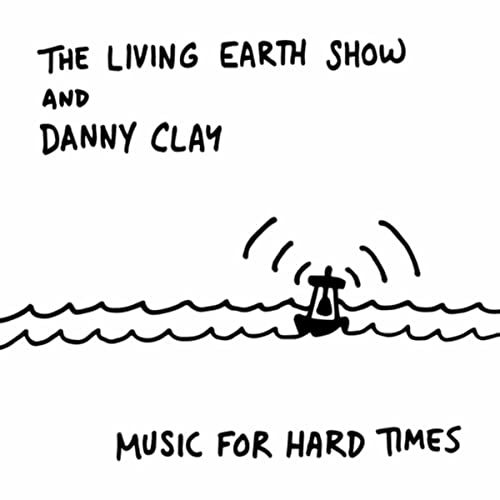 Danny Clay: Music for Hard Times The Living Earth Show/Danny Clay (Earthy Records)
Danny Clay: Music for Hard Times The Living Earth Show/Danny Clay (Earthy Records)
A self-described “sonic resource for those in need of comfort and calm”, Danny Clay’s Music for Hard Times is difficult to classify. Part anthology of found sounds, part education project, this album’s 15 tracks were distilled from several thousand hours of sound files. Those in Part 1 were recorded by Andy Meyerson and Travis Andrews of the San Francisco guitar/percussion duo The Living Earth Show, and the eight ‘calming strategies’ which Clay provided as starting points are included in the physical album, a gorgeously produced hand-bound book. Pleasingly vague instructions nestle alongside sequences of chords and single notes, exquisitely presented. You’ll either fall for a command like “imagine the most warm, enveloping harmony you can think of” and sense what Clay is getting at with his doodles and graphics, or you won’t. But, approach this release with an open mind and a big heart, and you’ll be won over. As artistic responses to Covid go, this one is a charmer. Snatches of ambient sound spar for attention with the sounds of toy instruments, and I’m disappointed that the music generated by a kombucha jug didn’t make the final cut.
Part 2 was created with the help of singers and instrumentalists at the San Francisco Conservatory. Track 10’s antiphonal vocal lines (provided by the San Francisco Girls Chorus) are sublime, and the way in which the disparate instrumental lines merge into choral textures in Track 11 is nifty. Clay’s finale is an extended A major chord, the colours shifting, the textures thickening and thinning. Reach the end and you’ll instantly start exploring the work again. Highly recommended. And, as mentioned, acquire the physical disc: design-wise, it’s a work of art.
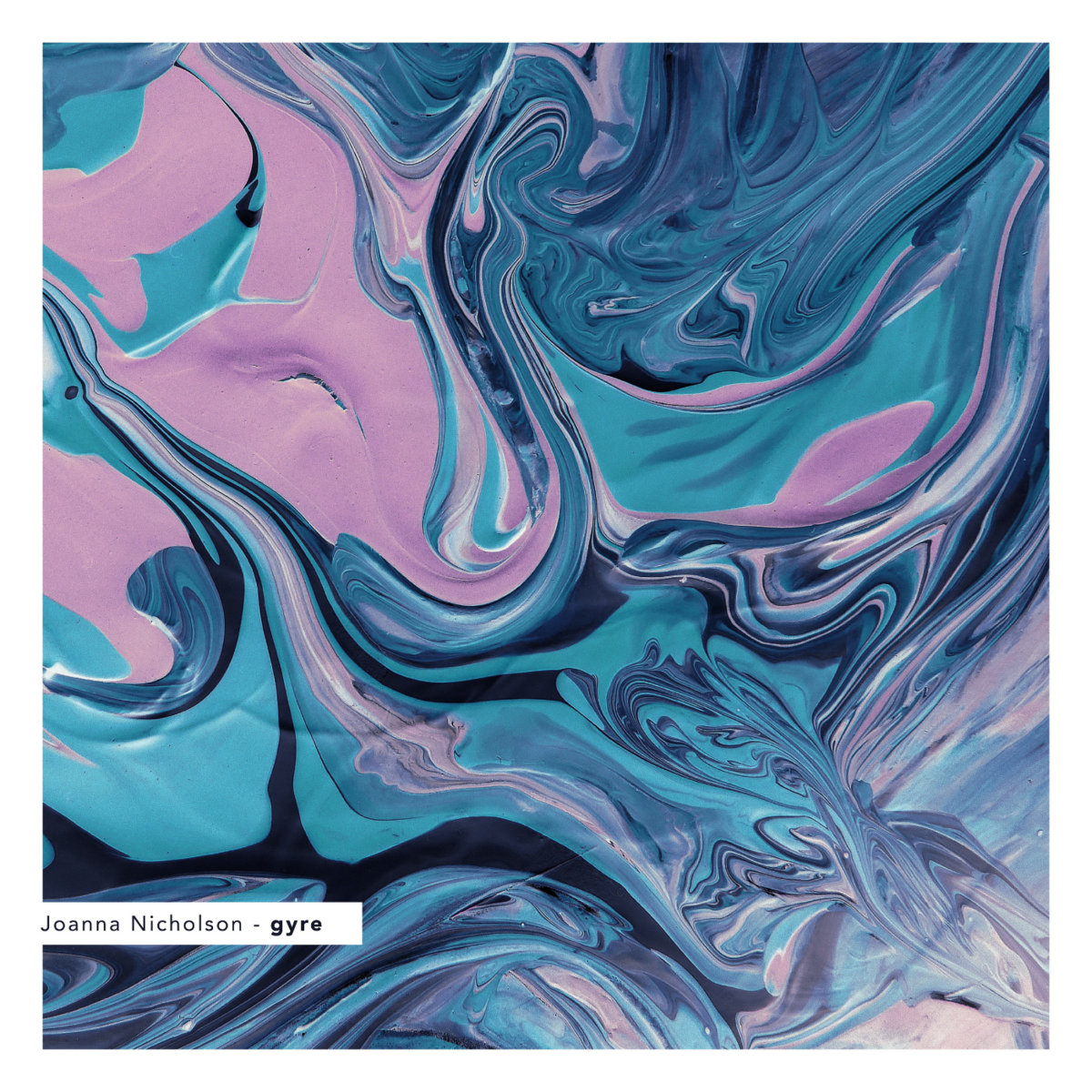 Joanna Nicholson: Gyre (TNW Music)
Joanna Nicholson: Gyre (TNW Music)
Scottish clarinettist Joanna Nicholson has a strong sense of what a big yet focused sound the clarinet can make. She has written, for example, that “the physicality of sound projection in a 1000+ seater venue” can be particularly “muscular and powerful”. In the 25 minutes of music in William Sweeney’s 1976 composition “Nine Days Piobaireachd” for clarinet and drone we hear her sound at its most delightfully communicative and persuasive. It is not all about the strength of sound. There is also joy to be heard in the urgency and momentum of her story-telling in the Sweeney work. For this composition, William Sweeney used the form of a pibroch, a set of variations on a ground ("urlar") for the Scottish Highland bagpipe, and developed figures which, rather than copying the bagpipes, bring out the character of the clarinet. Sweeney, a clarinettist himself, wrote the piece in his mid-twenties to mark the 50th anniversary of the 1926 General Strike. The original dedicatee of the piece was Alan Hacker.
“Nine Days” takes up roughly half the album. It has been fascinating to contrast this new performance with an old BBC recording of Alan Hacker playing it live in Edinburgh, which William Sweeney has kindly allowed me to listen to. Whereas Hacker's reading can be elegiac, inward, reflective, measured, and his tone can be raspier, Nicholson's new recording is much more public and performative. There may be repetition and ritual here, yet the interest, propulsion, insistence, stamina and passionate intent of Nicholson's new performance never flag at any moment. I was gripped from start to finish. The other pieces are vignettes when compared with “Nine Days”. The opener and title track is also inspired by Scottish heritage, this time as experienced through nature. “Gyre” (pronounced as in ‘gyrate’) is a vivid composition by the clarinettist herself, and which refers to the overpowering sight of a spiral or vortex of thousands of gannets which she saw from her kayak at the Troup Head Bird reserve on the Aberdeenshire coast.
Nicholson has an utterly persuasive and spirited voice when she is heard on her own terms, as in these two pieces. Others may think differently, but I found the remaining three works on the album, in which she took on the challenge to interact with electronic sounds, more constraining - and ultimately far less interesting.
- Sebastian Scotney
- Joanna Nicholson on Amazon
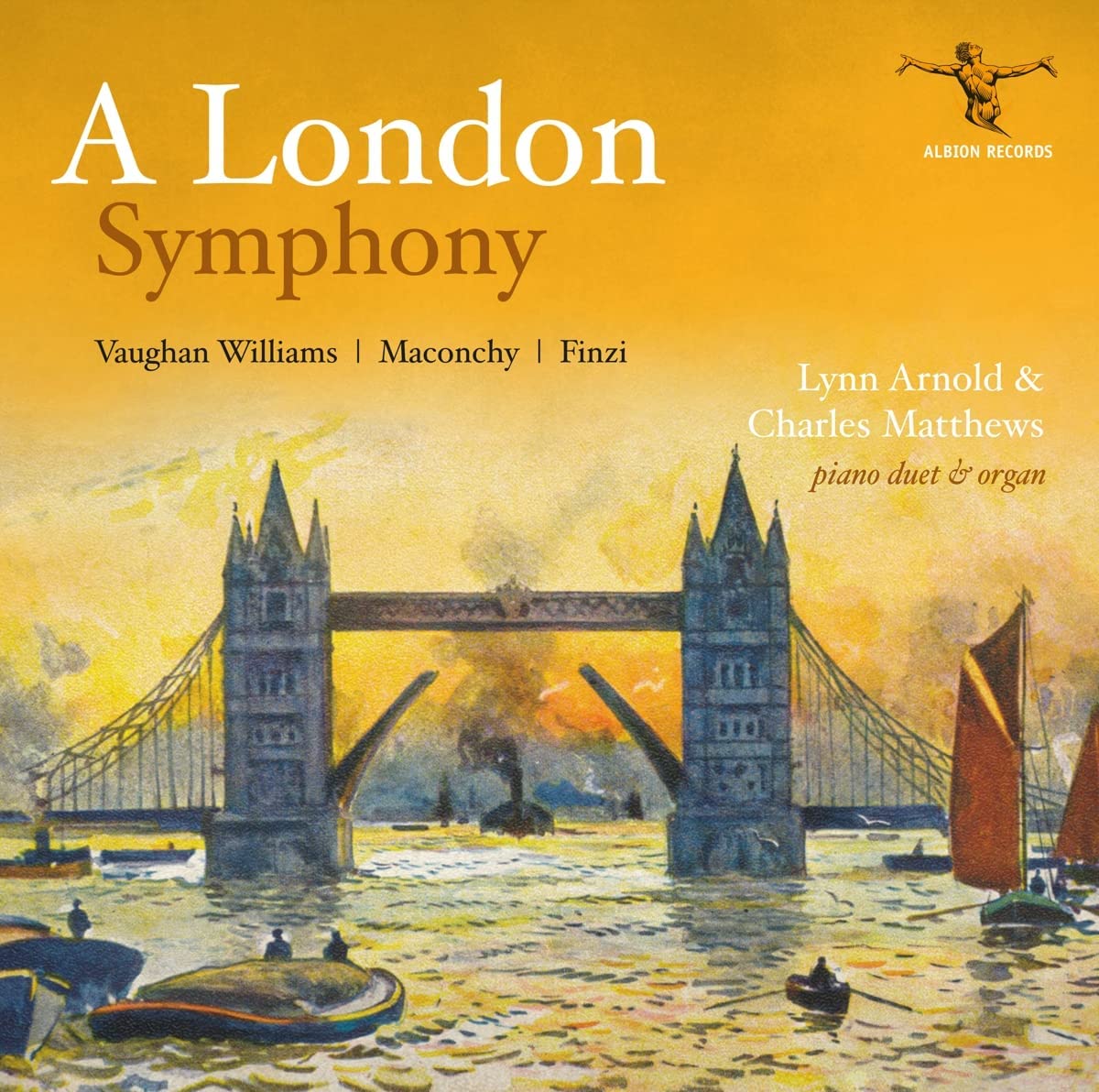 Vaughan Williams: A London Symphony (arranged for piano duet), plus music by Maconchy and Finzi Lynn Arnold & Charles Matthews (piano duet and organ) (Albion Records)
Vaughan Williams: A London Symphony (arranged for piano duet), plus music by Maconchy and Finzi Lynn Arnold & Charles Matthews (piano duet and organ) (Albion Records)
Lynn Arnold and Charles Matthews’ 2021 piano duet recording of Walton 1 demands to be heard. Here’s the follow-up: Vaughan Williams’ Symphony No. 2, heard here in a 1937 duet transcription by one Archibald Jacob. I’ve been googling Jacob and haven’t discovered much about him, other than that he published a book on musical handwriting. But his Vaughan Williams arrangement works well; contrapuntal lines emerge cleanly, and the first movement’s faster passages have an breezy, jazzy oomph. And, when the texture thins, you’re suddenly reminded of how much Vaughan Williams owed to his teacher Ravel; the same movement’s development section is exquisite here. The big modal outburst in the “Lento” thunders out, making the soft coda all the more moving. Arnold and Matthews give the scherzo plenty of lift and the finale never loses shape. As with the Walton, if you love the original, you’ll need to hear this version.
Interesting couplings too. Matthews and Arnold swap seats for the Preludio, Fugato e Finale by Elizabeth Maconchy, composed in 1967 for Susan Bradshaw and Richard Rodney Bennett. Maconchy’s freely dissonant but approachable language is winning. There’s so much space and light in the writing, a favourite moment being the huge chord which abruptly closes the middle section. Better known is Finzi’s Eclogue. Howard Ferguson’s two-piano arrangement is performed here, with Matthews playing the second part on organ. It’s an ear-tickling sound but not one I’d return to often; the organ tone, despite Matthews’ sensitive playing, smothers Finzi’s delicate little piece in a fusty funereal fog. Interesting, but I wouldn’t rush to hear it again. The Vaughan Williams and Maconchy are superb, though, and the disc has appealing artwork, good notes and handsome engineering.
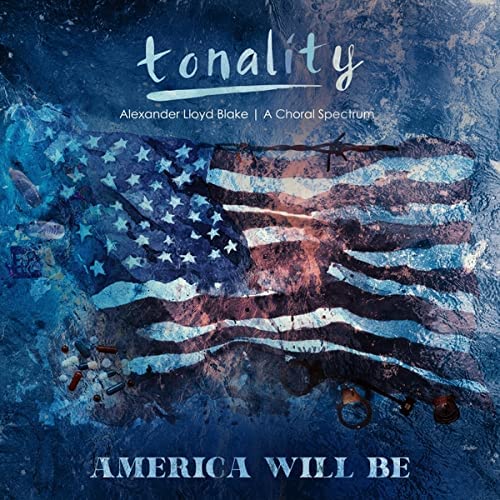
America Will Be Tonality/Alexander Lloyd Blake (Aerocade Music)
Alexander Lloyd Blake conceived Tonality in 2016 as a vocal ensemble accurately mirroring "the diverse cultures and ethnicites within the Los Angeles area", giving concerts on themes including gun violence, homelessness, climate change and women's rights. This, their second album, is as eclectic as you'd expect. Like Music for Hard Times, America Will Be was prompted by lockdown: in this case the pandemic's ability to widen divisions as well as bring communities together. And, as with the Danny Clay disc, the sheer sweep and power of the performances sweeps away any fears you might have over the album's worthiness. The close balance helps too, the hocketing, disembodied voices in "1223 Lyfe" packing a real punch. Lloyd Blake's texts decry the cruelty of the US penal system to music of irresistible catchiness. Shawn Kirchner's setting of Sylvia Plath's "Tulips" deserves to become a repertoire standard, and an arrangement of "Bridge Over Troubled Water" by Nathan Heldman is sung with extraordinary boldness and warmth.
Extracts from Greta Thunberg's UN speech form part of "The New Collective Consciousness" by Joseph Trapanese, its slowly shifting harmonies reflecting the melting of a glacier in Iceland. Sam Cooke's "A Change is Gonna Come" sounds marvellous in this a capella arrangement, and the closing number, "#UnitedWeDream" suggests that all hope is not lost. Texts aren't included, and it's a shame that soloists drawn from within the ensemble aren't given a shoutout in the booklet. It's still great, though: an occasionally angry but overwhelmingly optimistic album for troubled times.















Add comment